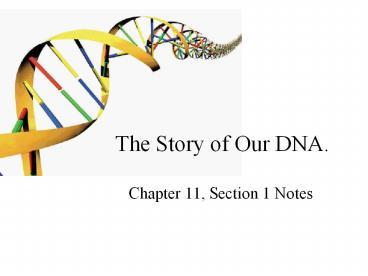The Story of Our DNA. - PowerPoint PPT Presentation
1 / 18
Title:
The Story of Our DNA.
Description:
The Story of Our DNA. Chapter 11, Section 1 Notes Important Discoveries: DNA s Function Frederick Griffith (1928) Transformation -Turned non-lethal bacteria ... – PowerPoint PPT presentation
Number of Views:137
Avg rating:3.0/5.0
Title: The Story of Our DNA.
1
The Story of Our DNA.
- Chapter 11, Section 1 Notes
2
Important Discoveries DNAs Function
- Frederick Griffith (1928) Transformation
- -Turned non-lethal bacteria into lethal
- -Hypothesized that a gene was responsible (He did
NOT know what biomolecule genes were made of)
3
Avery (1944)
- DNA is the molecule responsible for heredity
- a. Treated an extract from the heat-killed
bacteria with enzymes to destroy everything
except the nucleic acid. - Resulted in an identical outcome to Griffiths
experiment
4
Hershey-Chase (1952)
- -Studied bacteriophages
- -Determined that the DNA not the protein coat was
the source of genetic information
5
Now that scientists agree that DNA carries the
information
- How is DNA organized?
6
Chargraff (1950)
- Determined that nucleotides (the building
blocks of DNA) occur in specific ratios - - Guanine cytosine
- - Adenine thymine
- Did not know why this was true, only that every
organism followed this rule
7
Franklin (1950s)
- - Used x-ray diffraction
- - Three important pieces of information
- 1) Each strand is coiled (helix)
- 2) Two strands of in the structure
- 3) The nitrogen bases are near the center
8
Watson and Crick (1953)
- - Used Franklins experiment to determine the 3D
structure of DNA - -The double helix explained both how DNA could
carry information and how that information could
be copied - - Their model explained why AT and CG
9
What we know now about the structure of DNA
- Double helix
- Made of a phosphate backbone
- Rungs are the nucleotide bases
- Bases attach in certain patterns
- C ? G
- A ? T
- One side is called the 3 side the other is
called 5 - On the ends of the chromosomes in eukaryotes are
structures called telomeres that are repeating
bases that protect the DNA
10
(No Transcript)
11
DNA Replication
- The process of duplicating DNA
12
Commonalities in all organisms
- One side of the double helix gives the
instructions for the other - DNA replication occurs in both directions
- The site where DNA separation and duplication
occurs is called a fork
13
Prokaryotes
- More simple
- DNA is not in nucleus
- Plasmid single, circular DNA molecule
- Much less DNA than a eukaryote
- DNA replication begins at a single point
14
Eukaryotes
- DNA is more complex
- DNA is in a membrane-bound nucleus
- DNA is wrapped tightly around proteins to form
chromosomes - More DNA than prokaryotes
- DNA replication occurs at hundreds of points
15
How Replication Occurs
- Step 1 DNA is opened
- DNA Helicase reduces the strain caused by the
unwinding of the DNA
16
Step 2 New DNA is formed
- DNA Polymerase Helps the daughter strand form
by matching base pairs - Also proofreads the DNA and corrects mistakes
- Complimentary base pairs are attached to each
side of the now single-sided DNA - Each strand acts as a template
- New strands of DNA are ½ new and ½ original
- DNA has a north and south they are called
5 and 3 - Base pairs are copied following the 3 to the 5
direction of the parent strand
17
- Leading strand the side of the DNA that is
replicated faster follows the 3 ? 5 of the
parent strand - Lagging strand It is replicated more slowly
- Okazaki fragment the pieces that are formed in
the lagging strand, because replication can only
occur in the 3 to 5 direction as the DNA is
unwound.
18
Step 3 The pieces of DNA are connected
- DNA ligase attaches the Okazaki fragments
together

